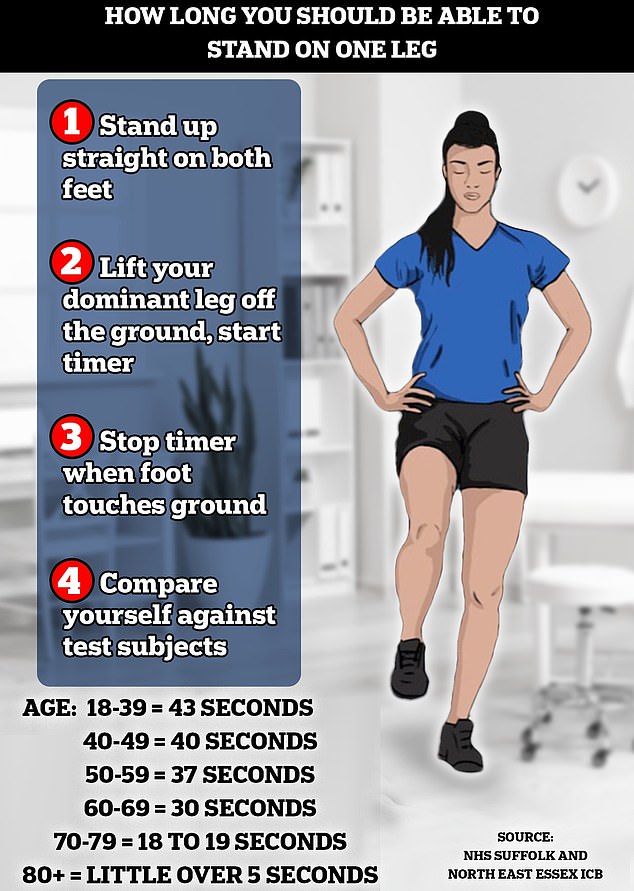Do you want to know how strong your heart is for your age?
It is not necessary to embark on complicated tests, such as running on a treadmill at maximum speed wearing all kinds of sensors.
Instead, it’s about running for 12 minutes and seeing how far you get. You can also do it by walking at a fast pace or jogging.
The scientific tool is officially known as The Cooper Test and is designed to measure how much oxygen your body uses during exercise, known as VO2 max.
The higher your VO2 max, the more efficiently your heart is said to push blood to your organs and tissues, indicating that the organ is healthy.
Studies have shown that those with a high VO2 max for their age are less likely to die from heart disease than those with lower scores.
The test was developed by American physician Kenneth Cooper in 1968, who originally designed the tool to measure aerobic fitness in the US military.
It can be done on a treadmill, running track or any flat, hard surface.
The Cooper Test, originally developed for the US military, is a science-backed way to measure your fitness level.
You run, jog, or briskly walk for 12 minutes without stopping and, using a distance tracking app like Strava or Apple’s Health feature, record how many meters you cover.
A results table shared by the fitness website. Very good shape reveals the distances that are considered excellent, above average, average, below average and poor.
The figures are stratified by gender and age up to 50 years.
Men in their 30s should be able to run 1.9 kilometers (1.1 miles), while women of the same age should be able to run 1.7 kilometers, or about a mile.
If a man can run 2.6 km, or 1.6 miles, at age 30, his VO2 is considered “excellent.” The same goes for 30-year-old women who manage to cover 2.5 kilometers or a mile and a half.
For middle-aged people, the threshold is slightly lower. The average man in his 50s can cover a distance of just under a mile, or 1.6 km, in 12 minutes. If you reach 2.4K, or one and a third miles, your performance is ‘excellent’.
The average distance for a woman in her 50s can cover 0.8 miles, or 1.4K, while any distance over 2.2K, or more than a mile, is excellent.
Anything below between 1.1K and 1.6K is considered poor, depending on the age group.
| AGE | EXCELLENT | ABOVE AVERAGE | AVERAGE | BELOW AVERAGE | POOR | |
|---|---|---|---|---|---|---|
| Male 20-29 | more than 2800 meters | 2400-2800 meters | 2200-2399 meters | 1600-2199 meters | less than 1600 meters | |
| Women 20-29 | more than 2700 meters | 2200-2700 meters | 1800-2199 meters | 1500-1799 meters | less than 1500 meters | |
| Men 30-39 | more than 2700 meters | 2300-2700 meters | 1900-2299 meters | 1500-1999 meters | less than 1500 meters | |
| Women 30-39 | more than 2500 meters | 2000-2500 meters | 1700-1999 meters | 1400-1699 meters | less than 1400 meters | |
| Men 40-49 | more than 2500 meters | 2100-2500 meters | 1700-2099 meters | 1400-1699 meters | less than 1400 meters | |
| Women 40-49 | more than 2300 meters | 1900-2300 meters | 1500-1899 meters | 1200-1499 meters | less than 1200 meters | |
| Men 50 | more than 2400 meters | 2000-2400 meters | 1600-1999 meters | 1300-1599 meters | less than 1300 meters | |
| Females 50 | more than 2200 meters | 1700-2200 meters | 1400-1699 meters | 1100-1399 meters | less than 1100 meters | |
| Source: Very good shape | ||||||

Balancing on one leg continuously for more than 40 seconds is a key sign of strength and mobility among people aged 18 to 39, according to the health service.
The test does not include scores for those over 50, although older adults can use a digital calculator to calculate your VO2 Max result.
The VO2 Max score is not the only simple measure that indicates how healthy you are for your age.
Experts also say that the number of push-ups an individual can perform is a good indicator of strength and endurance, which studies show can indicate how long a person will live.
This is because the exercise engages most of the major muscle groups throughout the body, including the legs, abs, shoulders, back, and arms.
According to the Mayo Clinic, young men should aim for 28 push-ups and women should aim for 20.
Ten years later, up to 45, the Mayo Clinic says women should be able to do 14 push-ups, while the count is 16 for men.
For 55-year-olds, the count drops to 10 push-ups for women and 12 for men.
For older age, as listed by the Mayo Clinic, both men and women age 65 should be able to do 10 push-ups at a time.
Research has also shown that older people who can balance on their leg for more than 10 seconds have a greatly reduced risk of dying in the next decade.
This is because a person’s balance ability indicates their overall strength level and their ability to prevent trips and falls, which is a leading cause of death among older people.

